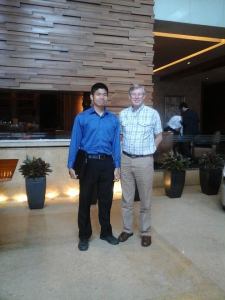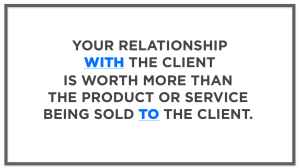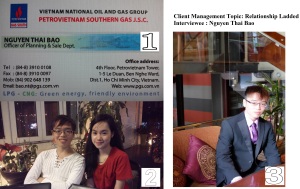Perception of client retention from client’s perspectives
Interviewed by Truong Thien Kim Long – s3324490 – Group 1 SGS
Readers know how agency does good to keep clients. It may be objective or subjective based on a writer’s perspectives. Have the readers ever thought of the opposite view? Join this post and imagine, what client thinks of the agency in one case study, presented in an interview.

(Colgate, n.d)

(Wpp, 2007)
An interviewee is Ms Nguyet Minh, Colgate’s Brand Manager. She specializes in FMCG industry and has 9-year working experiences; Ms Minh shows her professionalism and worldly-wise statement through her commitment to Colgate.

(Minh’s facebook, 2012)
“Colgate’s people concentrate on core values: Care – Global Unity – Nonstop Improvement. Minh said, three values are a basis of business strategy since they reflect Colgate’s lifework. Due to these values, its people have grown with Colgate and this is also the reason why Minh has become expert in being Colgate’s brand manager.
Minh gave the case study of Y&R and presented her perspectives about client retention. “Y&R works for Colgate-Palmolive in 4 years; however, there was a campaign, Y&R failed to satisfy us seriously”, said Minh. The campaign presented new Colgate toothpaste in Vietnam market that had the same functions but better quality than a competitor P/S. It was anti tooth decay and gave consumers pure breath, firmer and whiter teeth. Y&R helped Colgate run the campaign and attract customers (Minh 2014).
The problem is mutual communication. Y&R did not understand a brief but no asking at all. No pro-activeness in getting client updated with the campaign that made Colgate feel no more as the client who is buying a service. Y&R dissatisfied Colgate by offering few options and unreasonable rationale for the campaign. These facts resulted in Y&R’s unprofessionalism, damage to Colgate’s trust and bad reputation (Minh 2014). Y&R also had no understanding of client’s market and insights.
Development of Trust
“Y&R is our long-term partner but the failed campaign destroyed our trust”, said Minh. Sobel (2010) stated Trust is a critical key in client relationships. Client trusts in agency’s capability by doing creative work and everything said must be supported with accurate facts and figures. Product’s image satisfies client’s needs so as to make them trust the agency (Casul 2012). Solomon (Chapter 3, 2008) asserted the agency must live the client’s brand by being open and seeking new information and insights. You only live your client’s brand when you have research on their brand and product’s insights. You see the brand as yourself that helps you understand it clearly. The way you love yourself is the way you love the brand!
To give and keep Promises
“Colgate pays for Y&R but we feel we depend on them for helps” (Minh 2014). Lack of pro-activeness and no understanding of the brief caused this fact. Solomon (Chapter 6, 2008) stated the agency must take the brief seriously. It was Y&R’s failure in understanding the brief. A good brief is important to obtain great creative work; if you cannot make yourself an expert on client’s product, you fail to keep promises with them (Solomon, Chapter 9 2008). Deliver what you promise and do not promise what you cannot deliver (Casul 2012). Y&R’s bad performances resulted in no keeping promises with Colgate. No understanding the brief matters since you do not ask anything so we cannot support you; “it is a bad attitude towards your promise”, Minh’s viewpoint.
Quality-Price-Time Triumvirate Model
“Colgate pays a service but Y&R does not assure the quality” said Minh. Casul (2012) asserted the agency should educate clients on quality and price; however, Colgate did this task instead. Minh added, Colgate has to pay additional fees because we want to speed the process up. It is costly to get the quality fast; without additional fees, everything seems slow. “Although we pay fees, it still seems like we do not pay anything for the service” said Minh. This point argues with Casul’s view, you can neither get the work cheap nor fast and it is either not a good quality. Moreover, “you can get good work cheap but it takes a long time” (Casul 2012); Y&R case study pointed a serious problem not to get the work cheap, good and it was a long time, too.
Hence, differences are in comparing communication theories and practices. The problem arose from the agency’s bad performances. Thanks to Minh’s advice, I present recommendations in client retention. Y&R is excellent; however, its local agency fails to satisfy clients and face bad reputation. Solomon thought the agency must get the client involved in the process early (Chapter 18, 2008); the process will be better. The client feels happy because they do not work alone. Additionally, client’s observation helps the agency check the work’s quality. “Y&R should have been proactive in contacting with Colgate during the process”; “quality does matter and we want Y&R assure it for us” (Minh 2014). “Don’t hesitate to ask, this is a way keeping us updated”, shared Minh; “We are willing to answer the questions”. Asking questions makes sure you understand us and go on right track. Without interpreting the brief, it is impossible to start. It is a must to understand the client’s insights and market. Nevertheless, Y&R had little research on Colgate and got briefing wrong. You should live your client’s brand (Solomon 2008), feel it, love it as love yourself then you know to do the best work for your client.
References
Casul, M, 2012, “Lecture 2: The relationship marketing ladder”, Blackboard materials, pp. 4-6, viewed 5th May 2014.
Minh, P, 2014, Interview for Client Management assessment, 3rd May, 2014.
Sobel, A, 2010, “How strong is your client relationship?”, Blackboard materials, pp. 2-3, viewed 5th May 2014.
Solomon, R, 2008, The art of client service, KAPLAN, NY.





















